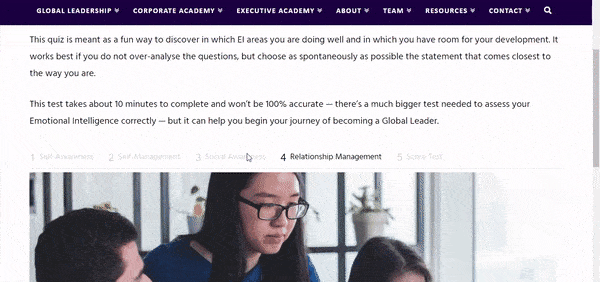As a global leader, understanding that societal behaviors and expectations across cultures influence a CEO’s performance and leadership success are vital for doing business. On some basic level, any leader worth their salt understands this — but there are studies that take the guesswork out of global business leadership efforts and offer unmatched educational opportunities for the global business sector.
The GLOBE (Global Leadership and Organizational Behavior Effectiveness) research program examines the relationships between societal culture and organizational leadership around the world. Initiated in 1991, the team has conducted two major studies, in 2004 and 2014 respectively, that have produced unprecedented results in the field of social science.
In 2004, the objective was culture-focused. Researchers aimed to identify, observe and understand how different societies around the world define cultural values, and how those values affect relationships in business.
The 2014 study honed in on how societal behaviors and expectations across cultures influence a CEO’s performance and leadership success, and if they feel the need to alter managerial styles due to cultural demands.
Because of these studies, global leaders now have the chance to analyze real data to optimize leadership efforts in both the society they’re based in and the societies they do business with on a regular basis.
Contents
- 2004 Study: Understanding the Relationship Between National Culture, Societal Effectiveness and Desirable Leadership Attributes
- 2014 Study: Globe CEO Study
- Conclusion
2004 Study: Understanding the Relationship Between National Culture, Societal Effectiveness and Desirable Leadership Attributes
The goal of the 2004 project was twofold:
- to identify how societies defined culture, and
- to assess how those varied definitions affected business interactions.
Over 17,000 middle managers across 62 cultures participated in the study.
Examining Culture Across Distinct Global Societies
Project GLOBE set out on a mission to measure and define what culture looks like across many societies. To do this, the research team created hundreds of items to test and assess across middle managers in different cultures. These items ranged from practices such as orderliness and consistency to values such as aggression vs. non-aggression.
The pilot study results were analyzed and converted into nine dimensions of societal culture, which are:
Performance Orientation: The degree to which a collective encourages and rewards (and should encourage and reward) group members for performance.
Assertiveness: The degree to which individuals are (and should be) assertive in their relationship with others.
Future Orientation: The extent to which individuals engage (and should engage) in future-oriented behaviors such as investing in the future.
Humane Orientation: The degree to which a collective encourages and rewards (and should encourage and reward) individuals for being fair and kind to others.
Institutional Collectivism: The degree to which organizational and societal institutional practices encourage and reward (and should encourage and reward) collective distribution of resources and collective action.
In-Group Collectivism: The degree to which individuals express (and should express) pride in their organizations or families.
Gender Egalitarianism: The degree to which a collective minimizes (and should minimize) gender inequality.
Power Distance: The extent to which the community accepts and endorses authority, power differences, and status privileges.
Uncertainty Avoidance: The extent to which a society, organization, or group relies on (and should rely on) social norms and rules to alleviate unpredictability of future events.
These dimensions allowed the GLOBE team to group countries into clusters organized by cultural similarities. The less one culture had in common with another, the farther apart they were in the delineated clusters.

Leadership and GLOBE’s Culturally Endorsed Leadership Theory (CLT)
With clusters in hand, the team set out to understand how leadership styles and success were affected by these cultural deviations.
Examining Leadership Across Distinct Global Societies
The hypothesis was that members of different societies most likely have varying expectations of their leaders, and these expectations are gleaned from cultural attitudes.
To test this theory, researchers surveyed the 17,000 middle managers with a questionnaire made up of 112 leader attributes and behavior items. The results produced 21 primary leadership dimensions constituting the Culturally Endorsed Leadership Theory (CLT).
The CLT was further broadened to six global leadership dimensions, which are:
- Charismatic/Value-Based Leadership
- Team-Oriented Leadership
- Participative Leadership
- Humane-Oriented Leadership
- Autonomous Leadership
- Self-Protective Leadership
The team could now combine the societal clusters with the CLT dimensions to analyze and produce detailed results.
2004 Results — The differences in expectations lie in exactly how trustworthiness is displayed and communicated.
The team found that different cultures generally have different expectations of leaders. As predicted, leaders do often act in styles that are consistent and endorsed within the society they are leading in. However, while some aspects of leadership are culturally dependent, other leadership expectations were found to be universal.
The primary shared universal value is trust. No matter what culture or country they are from, people want their leaders to be honest and trustworthy. The differences in expectations lie in exactly how trustworthiness is displayed and communicated.
For example, trustworthy leaders in the U.S. are interpreted as quick decision-makers, even if those decisions are approximative. In France and Germany, however, in order to be considered decisive, leaders are expected to make slower, more calculated choices.
Another noteworthy result is that performance orientation — the degree to which rewards are and should be encouraged based on employee conduct — is an important cultural driver across all societies. This is especially true in societies with high performance-oriented values, as they prefer leaders who are charismatic and participative.
2014 Study: Globe CEO Study
The 2014 study kept the influence of societal culture front and center, with a focus on CEO leadership as opposed to middle management roles.
Interactions between CEOs and their Top Management Team (TMT) are recognized as being incredibly important to a firm’s success. But what does this relationship look like across many cultures and how does it work if one CEO is managing a TMT spanning the globe?
GLOBE set out to find the answers to these questions as well as evaluating whether CEOs matched their leadership styles with the expected leadership values discovered in the 2004 study. If so, they wondered if matching leadership styles to cultural expectations lead to more success as a CEO, and vice versa.

CEO Research Study
GLOBE researchers collected data from over 1,000 CEOs and over 5,000 senior executives in corporations in a variety of industries across 24 countries.
The studies focused on four key questions:
- How does national culture influence the kinds of leadership behaviors expected in a society?
- What CEO behaviors generally lead to success?
- What are some distinctions between the high-performing and underperforming CEOs?
- How important is it that CEO leadership behaviors match the leadership expectations within a society?
2014 Results
The following results are based on findings in regards to the above-mentioned four key questions.
1. How national culture influences the kinds of leadership behaviors expected in a society
The team found that cultural values do, in fact, play a subconscious part in how employees view their leader. While the values themselves may not be obvious to the employees, the underlying expectations are there.
Leaders, in return, often learn what is culturally conventional and skew their behavior to position themselves in a better light in that society.
2. The CEO behaviors that generally lead to success
The GLOBE team generated six global leadership behaviors and 21 primary leadership behaviors that combined to make up six global leadership behaviors.
The six behaviors are:
- Charismatic
- Team Oriented
- Participative
- Humane Oriented
- Autonomous
- Self-Protective
A key finding was that among these six behaviors, charismatic leadership is consistently the most impactful regarding TMT dedication and Firm Performance. A leader that has a clear vision and is excited about bringing that vision to life often subconsciously influences team members to feel the same. Team members that feel part of a community working towards a common goal are more likely to align their personal goals with the charismatic CEO’s vision.
3. The distinctions between high-performing and underperforming CEOs
In line with the results from question 2, the more charismatic and visionary leaders outperform the autonomous and self-protected ones.
CEOs with high-performance orientation also outperform those who don’t focus on encouraging and rewarding team members for their performance.
Another interesting outcome is that both the high-performing and less successful CEOs performed critical behaviors, but the high-performing CEOs executed them at a far higher level than the rest. Consistently operating at a high-level is key.
4. The importance of CEO leadership behaviors matching leadership expectations within a society
The results matched the hypothesis: CEO behavior that emulates cultural leadership expectations produce better TMT and Firm Competitive Performance results.
Superior CEOs exceed societal expectations regarding charismatic and team-oriented leadership. Inferior CEOs fall short on expectations throughout all dimensions, are less visionary and less administratively competent.

Conclusion
GLOBE set out to understand how societies throughout the world varied in their cultural definitions and leadership expectations. They also questioned how these leadership expectations translated to CEOs, and if CEO performance behaviors changed based on cultural influence.
Their 2004 and 2014 studies were unprecedented in the world of global leadership research. The studies provide invaluable developments in social sciences that help global leaders enhance their leadership style and optimize their business.
GLOBE’s newest 2020 is now underway and is sure to provide even more distinguished data about cultural dimension and leadership throughout the world.
If you’re interested in staying up to date on the topic of global leadership, please sign up for our weekly emails here:


